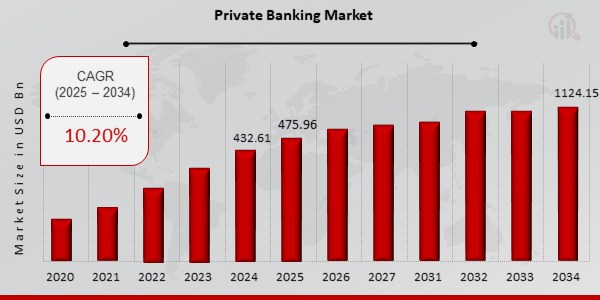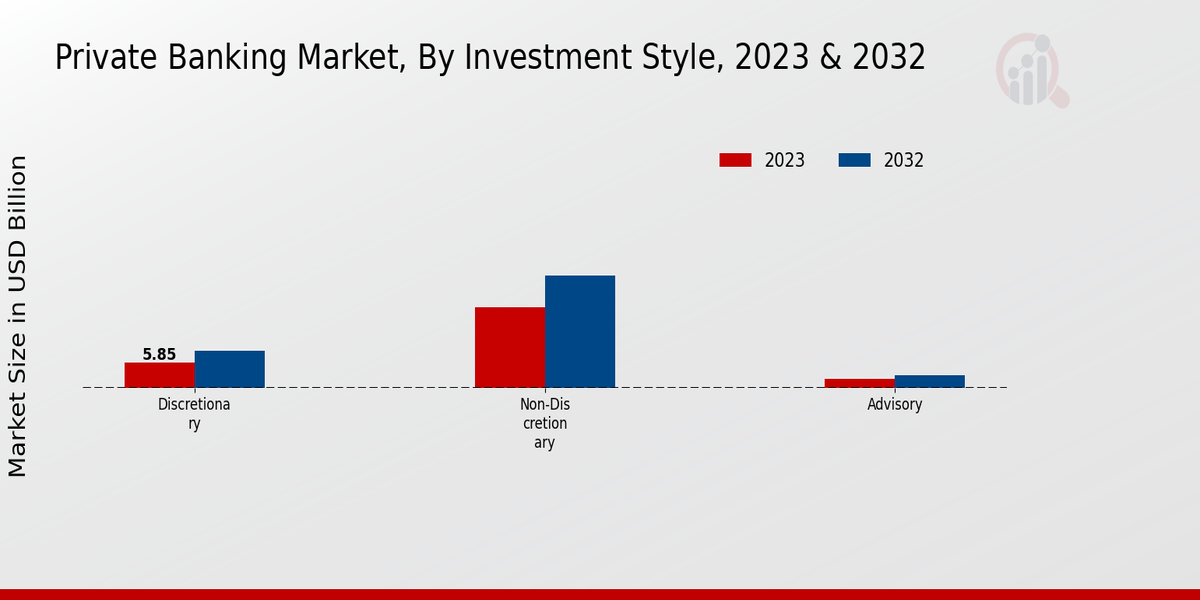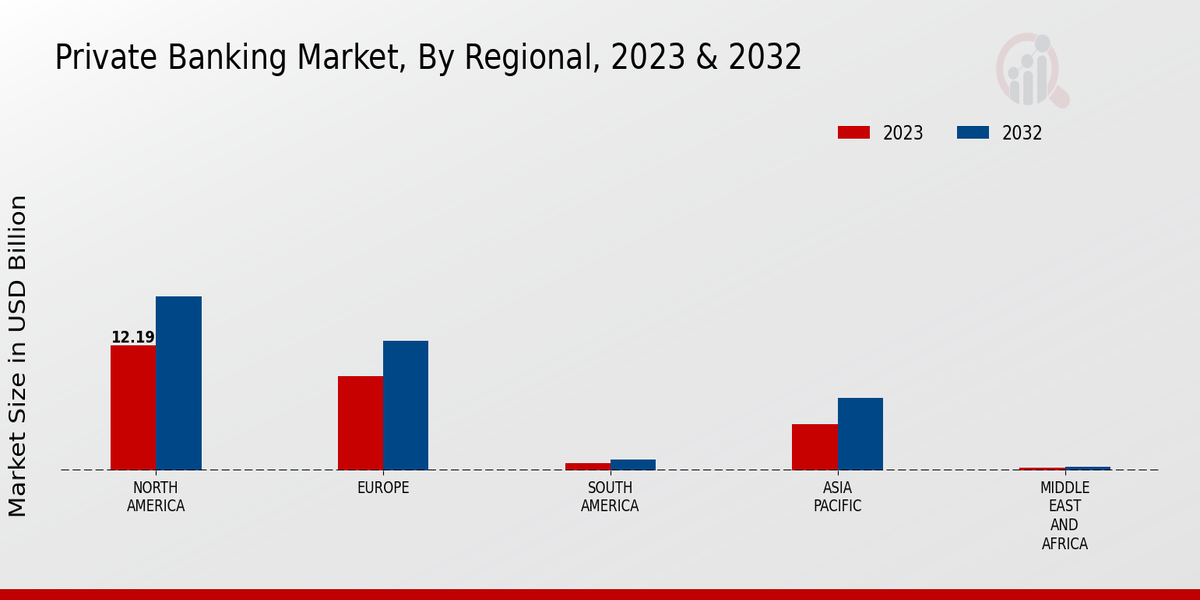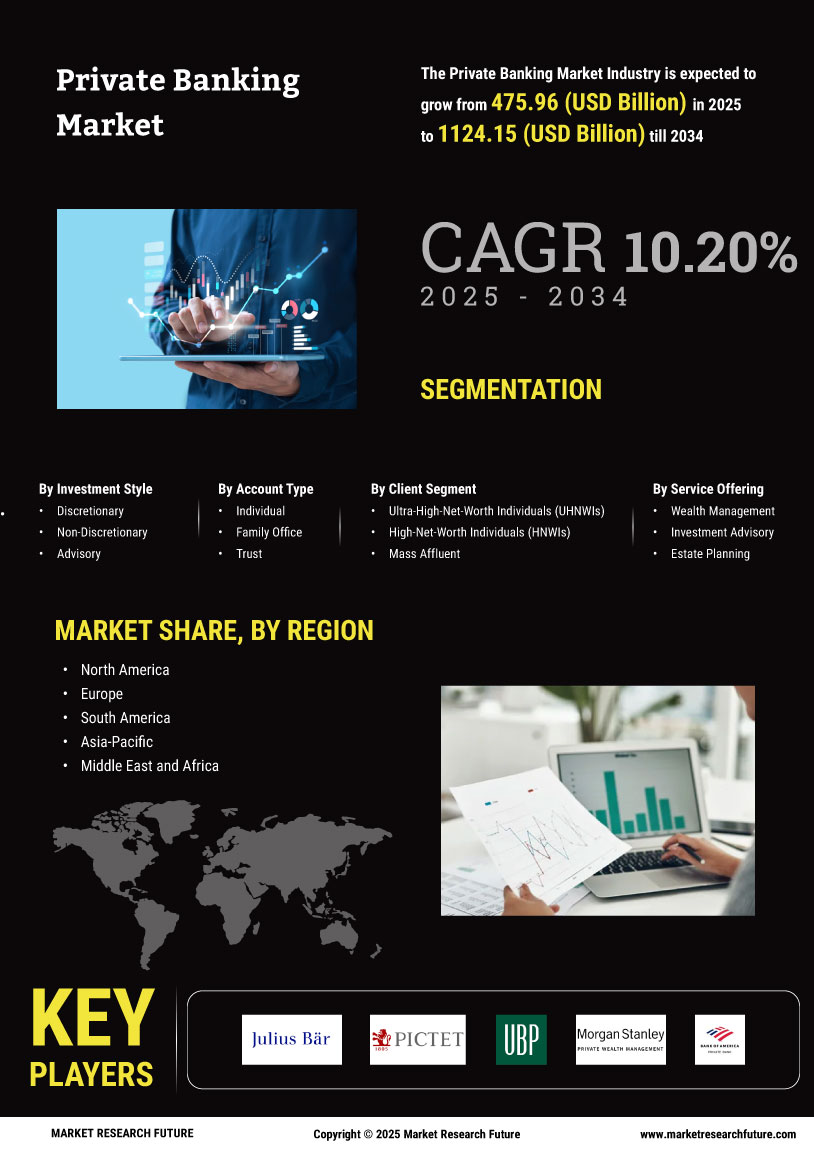Global Private Banking Market Overview:
Private Banking Market Size was estimated at 432.61 (USD Billion) in 2024. The Private Banking Market Industry is expected to grow from 475.96 (USD Billion) in 2025 to 1124.15 (USD Billion) till 2034, exhibiting a compound annual growth rate (CAGR) of 10.20% during the forecast period (2025 - 2034)
Key Private Banking Market Trends Highlighted
The growth of the Private Banking Market is being driven by several key factors, including rising wealth levels among high-net-worth individuals (HNWIs) and the increasing complexity of managing investments in a volatile economic environment.
Banks strive to provide personalized wealth management services to meet the diversified investment objectives of HNWIs. Opportunities lie in the emerging markets where the HNWI population is expanding. The increasing use of digital tools and technological advancements presents opportunities for banks to enhance client experiences and offer innovative investment solutions.
The trend towards sustainable and impact investing is also gaining momentum, creating opportunities for private banks to cater to the growing demand for responsible investment strategies.
Recent trends in the private banking market include increased regulatory scrutiny, which is influencing the operations and risk management practices of private banks. The rise of wealth advisory firms and the emergence of robo-advisors are challenging traditional private banking models, leading to increased competition and the need for differentiation.
The growing focus on environmental, social, and governance (ESG) considerations is also shaping the investment strategies of private banks and their clients.

Source: Primary Research, Secondary Research, MRFR Database and Analyst Review
Private Banking Market Drivers
Increasing Wealth Creation and Affluence
The rising number of high-net-worth individuals (HNWIs) and ultra-high-net-worth individuals (UHNWIs) globally is a significant driver of growth in the Private Banking Market. The increasing concentration of wealth among a select group of individuals has led to a growing demand for personalized and sophisticated financial services tailored to their unique needs.
Private banks are well-positioned to cater to this demand, offering a comprehensive suite of services, including wealth management, investment advisory, and estate planning.
The growing affluence of individuals in emerging markets is also contributing to the expansion of the Private Banking Market, as these individuals seek to preserve and grow their wealth.
Technological Advancements
Technological advancements are transforming the Private Banking Market, enabling private banks to enhance their service offerings and improve operational efficiency. The adoption of digital technologies such as artificial intelligence (AI), machine learning (ML), and blockchain is revolutionizing the way private banks interact with clients and manage their portfolios.
AI-powered algorithms are used to analyze vast amounts of data and provide personalized financial advice, while ML helps identify investment opportunities and manage risk.
Blockchain technology is enhancing transparency and security in financial transactions, making it an attractive option for private banks seeking to streamline operations and reduce costs.
Regulatory Changes
Regulatory changes, especially those that aim at increased transparency as well as the safeguarding of investors, are other driving dynamics in the emergence of the Private Banking Market.
Governments in different countries are enacting stringent rules that will ensure that the private banks operate within the set laws and standards. These measures are majorly, but not limited to, AML and KYC. AML is a protocol that private banks must follow to prevent money laundering from their institutions.
KYC is an essential aspect of any transaction ensuring the privacy and securing the information of the customer against any financial crimes that may ensue. In anticipation of compliance, the Private banks are investing more in the compliance infrastructure and the technology that supports these rules.
Further, another driving force for private banking is the increasing interest and pressure on companies to bank on ESG criteria. Notably, social impact relates to the desire to do well and good in the world in which they operate.
Private Banking Market Segment Insights:
Private Banking Market Investment Style Insights
The Private Banking Market segmentation by Investment Style includes Discretionary, Non-Discretionary, and Advisory. A discretionary investment style allows customers to have more control over their investment decisions, with the portfolio manager serving as an advisor.
In 2023, the discretionary segment captured the largest revenue share of 45.43%, owing to the rising demand for high-net-worth individuals to have personalized investment strategies. The non-discretionary investment style, where the portfolio manager invests on the customer’s behalf subject to predefined guidelines, accounted for a revenue share of 39.48%.
The advisory segment, where advice is offered without portfolio management, had a revenue share of 15.09%. Factors responsible for the growth of the market for advisory services include the rising proportion of the customer population demanding no-conflict advice and the increasing complexities in investment.

Source: Primary Research, Secondary Research, MRFR Database and Analyst Review
Private Banking Market Account Type Insights
The Private Banking Market is segmented by Account Type into Individual, Family Office, Trust, and Foundation. Among these segments, the Individual segment held the largest market share in 2023, accounting for over 60% of the Private Banking Market revenue.
The Family Office segment is expected to witness the highest growth rate during the forecast period, owing to the increasing number of high-net-worth individuals and families seeking personalized wealth management services.
Private Banking Market Client Segment Insights
The client segment in the Private Banking Market is categorized into Ultra-High-Net-Worth Individuals (UHNWIs), High-Net-Worth Individuals (HNWIs), and Mass Affluent. UHNWIs, with a net worth of over USD 30 million, are the most lucrative segment, accounting for a significant portion of the Private Banking Market revenue.
HNWIs, with a net worth between USD 1 million and USD 30 million, are also a key target group for private banks. The Mass Affluent segment, with a net worth below USD 1 million, represents a growing market opportunity for private banks due to their increasing wealth and sophisticated financial needs.
The Private Banking Market for the Mass Affluent segment is expected to grow steadily, driven by factors such as rising disposable income, increasing financial literacy, and demand for personalized financial advice.
Private Banking Market Service Offering Insights
The Service Offering segment is crucial in the Private Banking Market and is expected to experience significant growth in the coming years. Wealth Management is a core service in the Private Banking industry, accounting for almost half of the overall revenue.
Investment Advisory is another key service segment catering to the investment needs of high-net-worth individuals. Estate Planning, Tax Planning, and Philanthropy Advisory are specialized services that support clients in preserving and managing their wealth, optimizing tax efficiency, and fulfilling their philanthropic goals.
The increasing complexity of financial markets and regulatory landscapes is driving the demand for expert advisory services, making these segments poised for strong growth in the future.
Private Banking Market Regional Insights
Regionally, North America is expected to hold the largest market share, followed by Europe, APAC, South America, and MEA. North America is expected to remain the dominant region in the Private Banking Market, with a revenue of USD 12.31 billion in 2023, and is projected to reach USD 16.96 billion by 2032, growing at a CAGR of 3.69%.
The region's market growth is attributed to factors such as the presence of a large number of high-net-worth individuals (HNWIs), a well-developed financial infrastructure, and a growing demand for wealth management services.
Europe is expected to be the second-largest region in the Private Banking Market, with a revenue of USD 9.27 billion in 2023, and is projected to reach USD 12.58 billion by 2032, growing at a CAGR of 3.46%.
The region's market growth is driven by factors such as the presence of many private banks, the increasing wealth of HNWIs, and the growing demand for customized wealth management solutions. APAC is expected to be the fastest-growing region in the Private Banking Market, with a revenue of USD 4.51 billion in 2023, and is projected to reach USD 7.04 billion by 2032, growing at a CAGR of 5.23%.
The region's market growth is attributed to factors such as the rising wealth of HNWIs, the increasing demand for wealth management services, and the growing presence of international private banks. South America is expected to be the smallest region in the Private Banking Market, with a revenue of USD 0.75 billion in 2023, and is projected to reach USD 1.05 billion by 2032, growing at a CAGR of 4.21%.
The region's market growth is attributed to factors such as the rising wealth of HNWIs, the increasing demand for wealth management services, and the growing presence of international private banks.
MEA is expected to be a niche region in the Private Banking Market, with a revenue of USD 0.26 billion in 2023, and is projected to reach USD 0.37 billion by 2032, growing at a CAGR of 4.06%.
The region's market growth is attributed to factors such as the rising wealth of HNWIs, the increasing demand for wealth management services, and the growing presence of international private banks.

Source: Primary Research, Secondary Research, MRFR Database and Analyst Review
Private Banking Market Key Players and Competitive Insights:
Major players in the Private Banking Market are continuously focusing on expanding their geographical presence and developing innovative products and services to meet the evolving needs of their clients. Leading Private Banking Market players are investing heavily in technology and digitalization to enhance customer experience and operational efficiency.
Partnerships and collaborations are becoming increasingly common in the Private Banking Market as players seek to gain access to new markets and expertise. The competitive landscape of the Private Banking Market is expected to remain highly dynamic in the coming years, with new entrants and disruptive technologies challenging the established players.
UBS Group AG, the leading player in the Private Banking Market, has a strong global presence with operations in over 50 countries. The company offers a comprehensive range of wealth management services to high-net-worth individuals and families, including investment advisory, portfolio management, and estate planning.
UBS Group AG is known for its strong brand recognition, experienced wealth managers, and innovative digital solutions. The company has been consistently ranked among the top private banks globally.
Another major player in the Private Banking Market is Credit Suisse Group AG. The company has a strong presence in Europe, the Middle East, and Asia-Pacific. Credit Suisse Group AG offers a wide range of wealth management services, including investment advisory, wealth planning, and family office services.
The company is known for its expertise in managing complex and multi-generational wealth. Credit Suisse Group AG has a long history of providing innovative wealth management solutions and has been recognized for its commitment to sustainability.
Key Companies in the Private Banking Market Include:
-
Julius Baer
-
Pictet Wealth Management
-
UBP
-
Morgan Stanley Private Wealth Management
-
Bank of America Private Bank
-
Citi Private Bank
-
Rothschild Co
-
Wells Fargo Private Bank
-
HSBC Private Banking
-
Credit Suisse
-
JP Morgan Private Bank
-
Deutsche Bank Wealth Management
-
UBS
-
BNP Paribas Wealth Management
-
Goldman Sachs Private Wealth Management
Private Banking Market Developments
Several factors drive market growth, including increasing wealth creation, demand for personalized financial services, and technological advancements. The Asia-Pacific region is expected to witness the fastest growth due to rising disposable income and a growing affluent population.
Recent developments include the adoption of artificial intelligence and machine learning to enhance customer experience and streamline operations.
Additionally, banks are focusing on sustainability and responsible investing to meet the evolving needs of high-net-worth individuals.
Private Banking Market Segmentation Insights
Private Banking Market Investment Style Outlook
- Discretionary
- Non-Discretionary
- Advisory
Private Banking Market Account Type Outlook
- Individual
- Family Office
- Trust
- Foundation
Private Banking Market Client Segment Outlook
- Ultra-High-Net-Worth Individuals (UHNWIs)
- High-Net-Worth Individuals (HNWIs)
- Mass Affluent
Private Banking Market Service Offering Outlook
- Wealth Management
- Investment Advisory
- Estate Planning
- Tax Planning
- Philanthropy Advisory
Private Banking Market Regional Outlook
- North America
- Europe
- South America
- Asia-Pacific
- Middle East and Africa
|
Report Attribute/Metric
|
Details
|
|
Market Size 2024
|
USD 432.61 Billion
|
|
Market Size 2025
|
USD 475.96 Billion
|
|
Market Size 2034
|
USD 1124.15 Billion
|
|
Compound Annual Growth Rate (CAGR)
|
10.20% (2025-2034)
|
|
Base Year
|
2024
|
|
Market Forecast Period
|
2025-2034
|
|
Historical Data
|
2020-2023
|
| Market Forecast Units |
USD Billion |
|
Report Coverage
|
Revenue Forecast, Competitive Landscape, Growth Factors, and Trends
|
| Key Companies Profiled |
Julius Baer, Pictet Wealth Management, UBP, Morgan Stanley Private Wealth Management, Bank of America Private Bank, Citi Private Bank, Rothschild Co, Wells Fargo Private Bank, HSBC Private Banking, Credit Suisse, JP Morgan Private Bank, Deutsche Bank Wealth Management, UBS, BNP Paribas Wealth Management, Goldman Sachs Private Wealth Management |
| Segments Covered |
Investment Style, Account Type, Client Segment, Service Offering, Regional |
| Key Market Opportunities |
Digital transformation Emerging markets Sustainable Investing Wealth Advisory Family office services |
| Key Market Dynamics |
Rising wealth inequality Growing demand for customized financial solutions Increasing adoption of digital banking services Heightened regulatory scrutiny Technological advancements |
| Countries Covered |
North America, Europe, APAC, South America, MEA |
Frequently Asked Questions (FAQ) :
The Private Banking Market is expected to reach 475.96 USD billion in 2025 and is projected to register a CAGR of 10.20% to reach 1124.15 USD billion by 2034.
The key regions in the Private Banking Market are North America, Europe, Asia-Pacific, and the Rest of the World. North America is expected to hold the largest market share in 2023, followed by Europe and Asia-Pacific.
The key applications of Private Banking services include wealth management, investment advisory, estate planning, and tax planning.
The key competitors in the Private Banking Market include UBS, Credit Suisse, Goldman Sachs, Bank of America, and Morgan Stanley.
The key trends in the Private Banking Market include the rise of digitalization, the increasing demand for sustainable investing, and the growing importance of wealth management for women.
The Private Banking Market is expected to register a CAGR of 10.20% from 2025 to 2034.
The key challenges facing the Private Banking Market include increasing competition, regulatory changes, and the need to adapt to the changing needs of clients.
The key opportunities for growth in the Private Banking Market include the growing wealth of high-net-worth individuals, the increasing demand for wealth management services, and the expansion of the market in emerging economies.
Technology is having a significant impact on the Private Banking Market. Digitalization is enabling private banks to offer new services, improve customer service, and reduce costs.
The future of the Private Banking Market is expected to be positive. The market is expected to continue to grow as the number of high-net-worth individuals increases, and the demand for wealth management services remains strong.

















